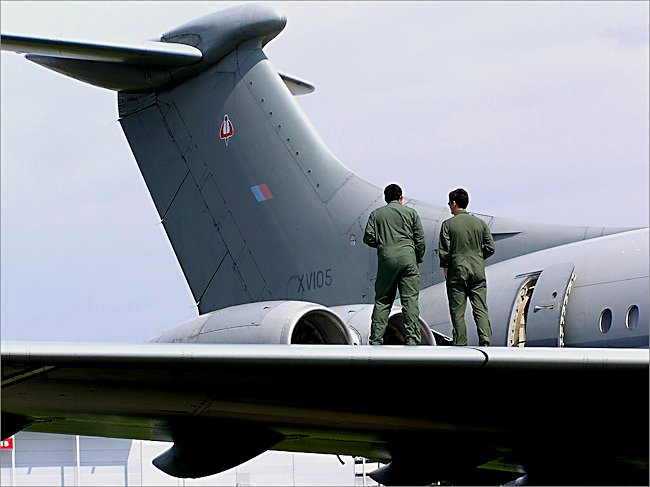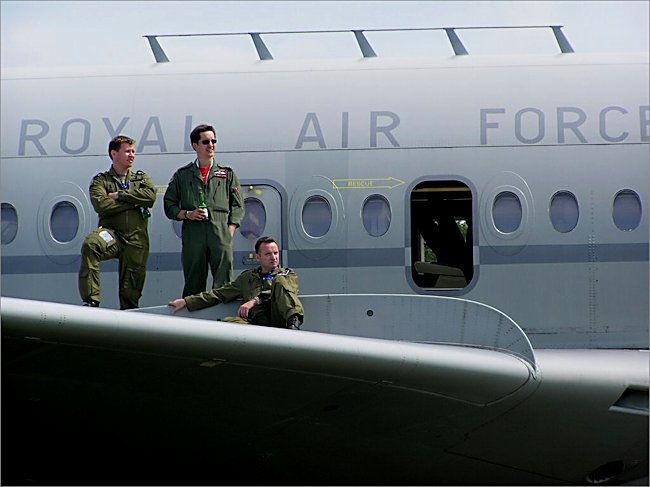Vickers VC10 Mk4 Tanker AAR
This is a photograph of a VC10 K. Mk. 4 Type 1170 one of the RAF's five inflight-refuelling tankers converted from a commercial passenger BAC Super VC10 Type 1151 jet airliner. VC10 stands for Vickers Civil design 10. The tenth civilian aircraft designed by the company. The initial concept of the VC10 was to provide a jet-powered airliner that could comfortably make use of the shorter runways commonly in use at the time and able to take off from runways that were at high altitude or in deserts which were causing problems to other civilian passenger jet liners of the day. The performance of the VC10 was such that it achieved the fastest crossing of the Atlantic - London to New York, by a jet airliner, a record still held in 2009 for a sub-sonic airliner although beaten by the supersonic Concorde. Only 54 in total were built. The VC10 served its intended market for only 15 years. It could have continued as a commercial passenger airline for much longer despite its high fuel consumption but the high noise levels on departure and approach sealed its fate.
In 2010 only 13 VC10s remain in RAF service as aerial refuelling (AAR) with seats for 124 passengers plus nine crew and transport aircraft.(AT). The cabin-freight door on the front left side of the aircraft enables the VC10 to be converted into a dual-role passenger/freight or full-freight configured jet aircraft. The cabin can hold up to 20,400kgs of palletised freight, ground equipment or vehicles, on its permanently strengthened floor in its full-freight role. Up to 68 stretchers may be fitted to enable medical evacuation.

Under the outboard section of each wing a Mk32 refuelling pod has been fiotted on the Tanker version of the VC10. It can carry up to 69,800kgs of fuel using its original eight fuel tanks; the fuel can be used to feed the aircraft itself or be dispensed to receiver aircraft that are equipped with a probeand- drogue refuelling system.
What is very clever is that the Vickers VC10 is capable of refuelling two aircraft simultaneously from the two underwing pods. The VC10 tanker can itself be refuelled from a suitably equipped VC10K or TriStar AAR aircraft by the use of an air-to-air refuelling probe, which is permanently attached to the aircraft nose.

There are two different AAR VC10 variants in the RAF air to air refueling fleet designated K3 and K4. The K3 is equipped with fuselage fuel tanks, mounted in the passenger compartment, and can carry up to 78 tonnes of fuel. These internal tanks are not fitted to the K4, which has a maximum fuel load of 68 tonnes. Each aircraft is a three-point tanker, with fuel being dispensed from the two wing-hoses or from the single fuselage-mounted Hose Drum Unit (HDU). The wing hoses can transfer fuel at up to 1000kgs per minute. The HDU can transfer fuel up to 2000kgs per minute and is usually used to refuel "heavy" strategic aircraft, although it can also be used by fast-jet aircraft.

For self defence, the aircraft's only countermeasures are its recent change to a low infrared paint scheme (grey), a radar-warning receiver and a Matador IRCM (Infrared Counter Measures) missile-protection system, which comprises two infrared jammers mounted under the engines at the rear of the aircraft. The aircraft also has a very limited passenger-carrying capacity used almost exclusively to carry ground crew and other operational support personnel.
The VC10 is now reaching the end of its service life, but continual modifications maintain the aircraft as a significant asset, enabling the rapid deployment of troops and their weaponry, and fast-jet fighter aircraft, to any theatre of operations around the world.
VC10 Tanker books


Tweet